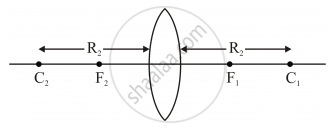Advertisements
Advertisements
Question
A convex lens made up of glass of refractive index 1.5 is dipped, in turn, in (i) a medium of refractive index 1.6, (ii) a medium of refractive index 1.3.
(a) Will it behave as a converging or a diverging lens in the two cases?
(b) How will its focal length change in the two media?
Solution
Given Refractive index of glass, μa = 1.5
Refractive index of Ist medium, μ1 = 1.6
Refractive index of IInd medium, μ2 = 1.3
(a) For Ist medium
`mu_1 > mu_a => mu_a/mu_1<1`
Hence, f > 0; concave lens or diverging lens
(ii) For IInd medium
`mu_2 > mu_a => mu_a/mu_2<1`
Hence, f < 0; convex lens or converging lens
(b)
(i) For first medium,

`1/f_1 = (1-(mu_a)/(mu_1))(1/R_1 - 1/R_2)_(-R_2 >0)^(R_1>0)`
`=(1 - 1.5/1.6)` (Positive number) for convex lens
`(1-0.9)` (Positive number)
`=(0.1)` (Positive number)
Original focal length
`1/f =(1-mu_0)(1/R_1 - 1/R_2)`
`1/f = -0.5` (Positive number)
`=> f_1/f = -0.5/0.1`
`=> f_1 = -5f`
Hence, focal length will be 5 times the original focal length and its nature will become diverging.
(ii) For second medium
`1/f_2 = (1-(mu_0)/mu_2) (1/R_1 - 1/R_2)`
`=(1 - 1.5/1.3) (1/R_1 - 1/R_2)`
`(1 -1.15)(1/R_1 - 1/R_2)`
`= 0.2 (1/R_1 -1/R_2)`
`=> f_2 /f = (0.2)/(0.1)`
`=> f_2 =2f`
Hence, focal length will be twice the original focal length and its nature (Converging nature) will remain same.
